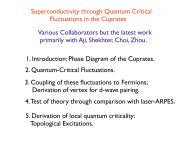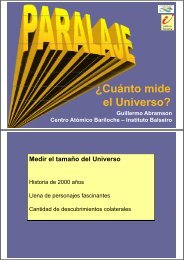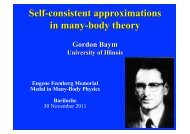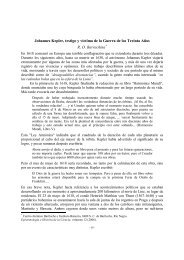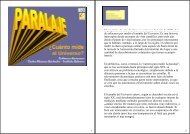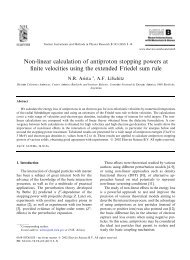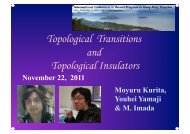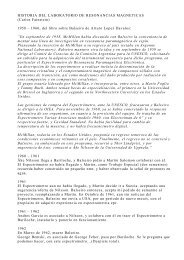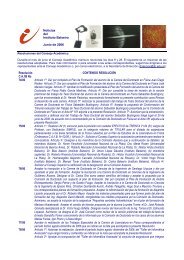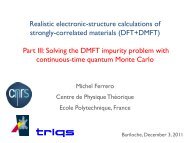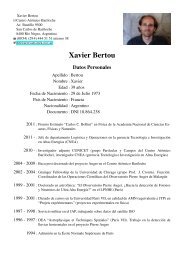Antoine Georges Strong Correlations From Hund's Rule Coupling
Antoine Georges Strong Correlations From Hund's Rule Coupling
Antoine Georges Strong Correlations From Hund's Rule Coupling
You also want an ePaper? Increase the reach of your titles
YUMPU automatically turns print PDFs into web optimized ePapers that Google loves.
<strong>Strong</strong> <strong>Correlations</strong><br />
<strong>From</strong> Hund’s <strong>Rule</strong> <strong>Coupling</strong><br />
<strong>Antoine</strong> <strong>Georges</strong><br />
Bariloche, November 2011
The Platters said:<br />
« Only U can do<br />
make all this world<br />
seem right… »<br />
… Take-home message of this talk:<br />
« Not only U, also J H » !<br />
Friedrich Hund<br />
1896-1997
Based mainly on two papers:<br />
Special thanks to:<br />
PRL (in print)<br />
Jernej Mravlje ; Luca ‘de Medici ; Markus Aichhorn; Michel Ferrero
I - A model study: 3 degenerate bands<br />
w/ same bandwidth 2D<br />
occupied by N electrons per site
N=1 electron N=2 electrons<br />
Quasiparticle<br />
weight Z<br />
vs. U/D<br />
N=3 electrons
Key points<br />
* At ½ filling (3 el. In 3 orbitals) Mott critical<br />
U c is strongly reduced upon increasing J<br />
cf. Bunemann, Weber, Gebhard et al.; Han, Jarrell, Cox PRB1998<br />
• IN CONTRAST, away from ½ filling (e.g.<br />
N=1,2,4,5) U c is strongly ENHANCED<br />
cf. L. ‘de Medici PRB 83, 205112 (2011)<br />
• At the same time, quasiparticle coherence<br />
scale (~ZD) is strongly SUPPRESSED as<br />
J is increased
As a result, for generic filling…<br />
(i.e. not ½ filling<br />
and not 1 electron or hole)<br />
e.g. for 2 or 4 electrons<br />
in degenerate t 2g bands<br />
… J is « Janus-faced » :<br />
it has two ANTAGONISTIC<br />
effects
Suppresses coherence scale « Bad metal » behaviour, small Z<br />
Increases U c Enhances range of metallic state
Intensity map of quasiparticle weight Z (J/U=0.15)<br />
revealing wide range of « bad metal » behaviour for N=2,4<br />
cf pioneering papers by P.Werner et al « spin-freezing » PRL2008, and<br />
K.Haule & G.Kotliar, New J. Physics 2009 in the context of pnictides
J- dependence of U c : estimate from the<br />
atomic limit
Reduction of coherence scale:<br />
effect of J on Kondo screening<br />
cf. Okada & Yosida, Prog. Theor.Phys 1973; Yanase & Yamada JPSJ1997;<br />
Pruschke & Bulla, EPJ 2005; Nevidomskii & Coleman PRL2010<br />
Ground-state degeneracy is reduced by J<br />
« more quantum » : T K goes down<br />
Toy model: N spin-1/2 coupled to K channels (exact screening)
Suppression of T K due to J :<br />
NRG evidence<br />
Pruschke & Bulla, EPJ 2005<br />
Mravlje et al. 2011
DMFT is an ideal tool<br />
to handle these effects:<br />
- Has atomic physics and<br />
multiplets right from the start<br />
- Describes screening<br />
of local atomic multiplets<br />
by electron hopping
A theoretical framework <br />
for strongly-correlated materials<br />
starting from ATOMS <br />
instead of an electron gas picture <br />
« Dynamical Mean-Field Theory » <br />
Correlated electrons in large dimensions:<br />
W.Metzner & D.Vollhardt, 1989 (Aachen)<br />
Dynamical Mean-Field Theory:<br />
A.G. & G.Kotliar, 1991 (Princeton/Rutgers)
Dynamical Mean-Field Theory: <br />
viewing a material as an (ensemble of) atoms<br />
coupled to a self-consistent medium!<br />
Solid: crystal lattice of atoms<br />
Atom<br />
Effective<br />
Medium
A simple example: the Hubbard model#<br />
Focus on a given lattice site:<br />
Atom can be in 4 possible configurations:<br />
Describe ``history’’ of fluctuations between those configurations
Drawing a map of early<br />
transition-metal oxides<br />
(both 3d and 4d)<br />
with Hund’s rule coupling<br />
as guidance
Correlation effects in 4d oxides due to J, not to Mott physics<br />
(except when strong splitting between orbitals)<br />
3d oxides: U/D ~ 4<br />
4d oxides: U/D ~ 2<br />
Focus in the following on:<br />
Technetium and Ruthenate oxides
``Atsushi Fujimori’s map of RMO 3 perovskites’’<br />
J.Phys Chem Sol. 53 (1992) 1595<br />
YTiO 3<br />
LaTiO 3<br />
CaVO 3<br />
SrVO 3<br />
Partially filled d-shells… and yet often insulators
-II- Record-high Neel temperature in<br />
Technetium oxide (SrTcO 3 )<br />
- contrast to SrMnO 3
Mechanism: SrTcO 3 (T N ~1000K)<br />
very close to Mott transition<br />
(In contrast SrMnO 3 is a more localized insulator, T N ~ 260 K)<br />
Mravlje,<br />
Aichhorn, A.G.<br />
arXiv:1108.1168<br />
LDA+DMFT
- III -<br />
Sr 2 RuO 4 : a Hund’s coupling<br />
correlated metal<br />
(J.Mravlje et al., PRL 2011)
Sr 2 RuO 4 : the `Helium 3’ of<br />
transition-metal oxides !<br />
• Huge high-quality crystals !<br />
• Has been investigated with basically all<br />
techniques in the experimentalist’s toolbox<br />
• 4d-row structural analogue of La 2 CuO 4<br />
• Beautiful review articles:<br />
- A.Mackenzie and Y.Maeno<br />
RMP 75, 657 (2003)<br />
- Bergemann, Adv. Phys. 52, 639 (2003)<br />
[Focus on dHvA quantum oscillations]
Yet, outstanding puzzles about this<br />
compound remain…<br />
• A 4d material<br />
expect not very large U (< 3eV)<br />
- Yet, effective mass enhancement (vs. band/LDA value)<br />
as large as ~ 5<br />
- <strong>Strong</strong> orbital dependence<br />
- Low Fermi-liquid coherence scale:<br />
- T 2 law obeyed only below ~ 30K<br />
- Quasiparticles suppressed above ~ 130K, at<br />
which interlayer resistivity crosses over from<br />
metallic to insulating
Basic electronic structure :<br />
• 4 electrons in t 2g shell<br />
• d xy orbital yields a quasi 2D<br />
band γ-sheet of FS<br />
- d xz , (resp. d yz ) bands with directional<br />
hopping along x (resp. y) α,β sheets
Fermi surface of<br />
Sr 2 RuO 4<br />
and populations from dHvA:<br />
FS from photoemission:<br />
β-sheet<br />
(0.9 electrons)<br />
α-sheet<br />
0.2 hole<br />
k y<br />
FS from quantum oscillations:<br />
k x<br />
γ-sheet (xy)<br />
1.3 electrons
Bands (LDA)<br />
~ 1.5 eV<br />
(xz,yz)<br />
~ 3.6 eV<br />
(xy band)<br />
But kinetic energies of all bands comparable
Effective masses<br />
- Rather large !<br />
- <strong>Strong</strong>ly orbital dependent.<br />
- The widest band has the largest eff. mass enhancement !
Dynamical Mean-Field Theory<br />
calculations (using full LDA bandstructure):<br />
- effective masses -<br />
- Increase of effective mass as J is increased<br />
- Orbital differentiation: xy heavier<br />
- Comparable mass enhancement<br />
would require U=5eV at J=0 !<br />
For<br />
U=2.3 eV
Quasiparticle coherence scale<br />
Inverse QP lifetime / T:<br />
Fermi Liquid @ low-T<br />
T-linear above ~ 400 K<br />
Reaches ~kT at ~ 70K<br />
Low-T calculations made possible by recent progress in<br />
DMFT technology: CT-QMC solver of P. Werner et al.
Comparison to ARPES
Self-energies vs. ARPES
Qualitative understanding: some hints<br />
from local picture (effective quantum impurity).<br />
4-electron subspace splits into:<br />
T=2,S=0: 5 states<br />
T=0,S=0: 1 state<br />
T=1,S=1: 9 states<br />
At J=0: all degenerate, 15-dim rep. of SU(6) symmetry<br />
Very high Kondo/coherence scale ~ fraction of an eV<br />
For non-zero J: SU(2)*SU(2), 9-fold ground-state multiplet<br />
Exactly screened local model Fermi liquid<br />
Suppressed T K<br />
J becomes active when larger than<br />
coherence scale of J=0 model
Orbital dependence:<br />
why is xy more correlated ?<br />
Hund’s coupling lowers the inter-orbital coupling:<br />
Individual fermiology of orbitals becomes relevant<br />
xy `effective hybridization strength’ to environment is<br />
smaller (by at least a factor of 2) than xz, yz<br />
Initial LDA eff. Hybridization:<br />
Proximity of van Hove singularity<br />
for xy makes DOS larger and<br />
<strong>Strong</strong>ly p-h asymmetric<br />
Both effects reduce<br />
hybridization
Another important class of materials for<br />
which Hund’s coupling- induced<br />
correlations are key:<br />
IRON-based superconductors<br />
pnictides & chalcogenides<br />
see previous talk by G.Kotliar<br />
Haule and Kotliar, New J. Phys 11 (2009) 025021<br />
+ several recent articles<br />
See also: Aichhorn et al. PRB 2010 (FeSe)<br />
Werner et al. arXiv:1107.3128 (BaFe2As2)
<strong>From</strong> model calculations to real<br />
materials: the happy marriage of<br />
DMFT with electronic structure<br />
(DFT) methods<br />
- an interdisciplinary effort<br />
started in ~ 1998 and still continuing<br />
today<br />
Anisimov, Kotliar, Poteryaev et al., 1997<br />
Lichtenstein & Katsnelson, 1998
Recent algorithmic breakthroughs <br />
entering a new age for DMFT approaches <br />
(and extensions) …!<br />
Continuous-time quantum Monte Carlo (CT-QMC)<br />
*Rubtsov 2005 Interaction expansion(CT-INT)<br />
*P. Werner, M.Troyer et al (ETH) 2006<br />
Hybridization expansion(CT-HYB)<br />
*Gull/Parcollet 2008 Auxiliary field (CT-AUX)<br />
* Submatrix updates (Gull et al. 2010) convergence in<br />
cluster size reached for some parameter regime (full k-<br />
dependence resolved)
Electronic structure with DMFT:<br />
The FLAPW (Wien2k) / Wannier route<br />
The TRIQS project: first release 01-11-11 !<br />
Toolbox for Research on Interacting Quantum Systems<br />
Project Leaders: Olivier Parcollet (CEA-IPhT), M.Ferrero (EP)<br />
Key developers of Wien2TRIQS: M.Aichhorn, L.Pourovskii,<br />
C.Martins, V. Vildosola, with also S.Biermann, A.<strong>Georges</strong><br />
Self-contained library of codes,<br />
including CT-QMC `impurity’ (DMFT) solver<br />
and Wien2TRIQS interface for DFT+DMFT calculations
To be presented<br />
(M.Ferrero, M.Aichhorn)<br />
together with introduction<br />
to LDA+DMFT<br />
at the….
Conclusions<br />
• Other pathways to strong correlations than Mott-<br />
Hubbard<br />
• Hund’s coupling crucial, especially for 4d<br />
oxides but also other materials (iron-SC)<br />
• 5d oxides: spin-orbit !<br />
• Splitting of orbital degeneracy also a key<br />
relevant parameter<br />
The DMFT framework<br />
helped by recent algorithmic breakthroughs,<br />
can handle these issues in a realistic<br />
way for specific materials.



